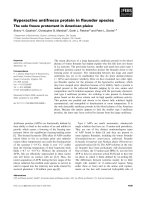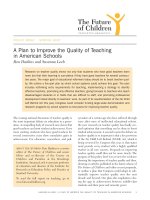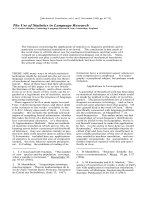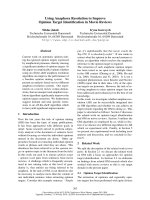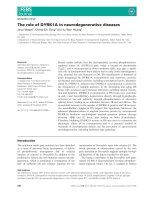The plan to improve the Quality of Teaching in American Schools docx
Bạn đang xem bản rút gọn của tài liệu. Xem và tải ngay bản đầy đủ của tài liệu tại đây (150.63 KB, 8 trang )
The rousing national discussion of teacher quality is
the most important debate on education in a gener
-
ation. A compelling body of research now shows that
good teachers can boost student achievement. Even
more exciting, students who have good teachers for
several consecutive years show cumulative gains in
achievement. For educators, researchers, and poli-
cymakers of a certain age who have suffered through
wave after wave of ineffectual educational reform,
the new research on teacher quality has finally cre-
ated optimism that something can be done to boost
student achievement. A second reason the debate on
teacher quality is so important is that a key provision
of the No Child Left Behind (NCLB) Act, which is
being reviewed by Congress this year
, is that states
must provide every student with a highly qualified
teacher in all core courses. Proposals on improving
teacher quality could thus not be more timely
. The
purpose of this policy brief is to review the evidence
showing the importance of teacher quality and then,
drawing on articles published in the latest volume of
The Future of Children and other recent proposals,
to outline a plan that Congress could adopt to sub-
stantially improve teacher quality over the next
decade and beyond. Our plan also emphasizes clos-
ing the gap in achievement between middle-class
students and their poor and minority peers.
HASKINS & LOEB | A PLAN TO IMPROVE THE QUALITY OF TEACHING IN AMERICAN SCHOOLS 1
POLICY BRIEF SPRING 2007
A Plan to Improve the Quality of Teaching
in American Schools
Ron Haskins and Susanna Loeb
Research on teacher quality shows not only that students who have good teachers learn
more but that their learning is cumulative if they have good teachers for several consecu-
tive years. The major goal of educational reformers today should be to boost teacher qual-
ity. We outline a five-part plan by which school systems could achieve this goal. The plan
includes rethinking entry requirements for teaching, implementing a strategy to identify
effective teachers, promoting only effective teachers, giving bonuses to teachers who teach
disadvantaged students or in fields that are difficult to staff, and promoting professional
development linked directly to teachers’ work. As part of its reauthorization of the No Child
Left Behind Act this year, Congress could consider funding large-scale demonstration and
research programs by school systems to test plans for improving teacher quality
.
ABOUT
THE
A
UTHORS
: Ron Haskins is a senior
editor of The Future of Children and senior
fellow and co-director of the Center on
Children and Families at the Brookings
Institution. Susanna Loeb is associate professor
of education and director of the Institute for
Research on Education Policy and Practice at
Stanford University.
To read the full report on teaching, go to
www.futureofchildren.org.
The Failures of American Education
Since the publication, in 1983, of A Nation at Risk—
the report by the U.S. Department of Education that
declared American public schools so bad that had a
foreign enemy inflicted such schools on us, we would
consider it an act of war—the nation has been
through several waves of education reform. All have
been, more or less, a response to three chronic prob-
lems: U.S. schools fare badly in international com-
parisons, the school dropout rate is high and proba-
bly rising, and a huge gap in achievement between
whites and blacks (with Hispanics in the middle on
most measures) emerges as early as age three and
persists throughout the school years and beyond—
and all this even though spending on public educa-
tion has more than doubled since A Nation at Risk
burst onto the national scene. Improving the quality
of the average American teacher would address all
three problems.
Good Teachers Make a Difference
A Nation
at
Risk
was not the first bomb to land in the
midst of the nation’s educational establishment. In
1966, at the behest of the federal government, soci-
ologist James Coleman of the University of Chicago
published one of the most controversial studies in the
history of social science research. Based on analysis
of data on 600,000 students from 4,000 schools, Cole
-
man and his team reached the conclusion that family
background was a more important determinant of
educational achievement than any characteristic of
the schools—teacher salaries, books in the library,
per
-pupil expenditures—traditionally assumed to
influence student achievement. At first Coleman’s
conclusion about the relative importance of family
background was rejected by many educators and
pundits, but eventually it came to dominate thinking
about education, especially because subsequent
analyses of Coleman’s data as well as other data sets
confirmed his findings. As an ever-expanding body of
research showed that most reforms designed to pro
-
mote school achievement or to reduce the gap
between ethnic groups made little progress toward
accomplishing either goal, a kind of pessimism set
-
tled over educational research and policymaking.
The recent findings on the importance of good teach
-
ing provide a welcome relief. At last high-quality and
large-scale studies are showing the impact of good
teachers on student achievement. One of the first
large-scale studies, published by William Sanders and
June Rivers of the University of Tennessee in 1996,
was based on test score results in mathematics for
students who were followed from grades three
through five. Teachers for each grade were divided
into five groups of equal size based on the improve-
ment they produced in their students’ math scores.
Students who had teachers in the top fifth of teacher
effectiveness for each of the three years scored about
50 percentile points better than students who had
teachers in the lowest fifth. Subsequent analyses
showed that teachers in the top fifth produced
improvement among all students, regardless of their
original scores or ethnic group. Another high-quality
study, this one by Eric Hanushek, John Kain, Daniel
O’Brien, and Steven Rivkin, used gain scores from
Dallas in grades four through eight to show that good
teachers are effective with students of all ability lev-
els, that first-year teachers are the least effective in
boosting student achievement, that teachers leaving
the public schools are less effective than those who
stay in teaching, and that students achieve more
when their teachers are of their own race.
Reviewers of these and other empirical studies have
almost uniformly agreed that the body of research on
teacher quality stands up well to careful scrutiny.
Teacher quality is the single most important feature
of the schools that drives student achievement.
A Plan to Increase Quality
Not surprisingly
, many researchers and educational
groups are putting together plans for raising teacher
quality. Though none has yet been fully tested, we
believe there is a good chance that combining spe
-
cific elements from these plans could raise the aver-
age quality of teachers countrywide. In selecting the
elements that we think are most promising, we
emphasize that any plan must be subjected to care-
ful evaluation. Indeed, a key feature of our approach
would be the incorporation of ongoing research that
would provide data needed both to judge success
and, where success was lacking, to adjust the plan
accordingly
.
Our plan is similar in some ways to a proposal by
Dan Goldhaber for the Center for American
Progress and to one by the Milken Family Founda-
2 THE FUTURE OF CHILDREN
tion several years ago that is now being implemented
with private funds. It also shares some features with
a plan set forth by Robert Gordon, Thomas Kane,
and Douglas Staiger for the Hamilton Project at the
Brookings Institution. And it is consistent with the
recommendations for formulating public policy con-
tained in the lead article of the new Future of Chil-
dren volume. Our plan differs from most previous
plans, however, in that we support neither the com-
plete elimination of teacher certification nor the
implementation of merit pay for teachers based
solely on gains in student test scores.
Selectively Implement Entry Requirements
Because open markets and competition maximize
consumer choice and producer efficiency, entry
requirements in any given market are suspect on the
grounds that they reduce both choice and competi-
tion. Nonetheless, many professions restrict entry to
the market they serve by creating standards and cer-
tification requirements that must be met before the
professional is allowed to practice. If the standards
and certification procedures are reasonable, and if
they are directly related to professional perform-
ance, the sacrifice in choice and efficiency can be a
good tradeoff. The patients of brain surgeons cer-
tainly think the tradeoffs are justified.
New programs that have reduced entry requirements
for teachers and focused on recruitment and selec-
tion, such as Teach for America and the New York
City Teaching Fellows, have demonstrated that eas-
ing requirements can greatly increase the pool of
prospective teachers. That said, this larger pool does
not appear to have led to dramatically better student
achievement, though there is evidence of small gains.
Similarly
, certification requirements themselves
have demonstrated some good effects. For example,
the Highly Qualified Teacher provision of NCLB
requires new teachers to pass an exam to demon
-
strate competence in the core subjects they teach.
This requirement appears to have improved the
basic academic ability of teachers entering schools
that serve the lowest-income students. Recent
research in North Carolina and New York also sug-
gests that certified teachers are somewhat more
effective in boosting student achievement than
teachers who are not certified.
Certification is intended to ensure that teachers have
a minimal level of competence as they begin their
careers. It can be a screening device to eliminate
potentially poor teachers. But it is a blunt instrument
that both lets some poor and mediocre teachers
through its screen and blocks some potentially
strong teachers. Thus, certification should not be the
final word in determining who teaches. Further eval-
uation once teachers are in the classroom is essential
to ensuring a strong workforce.
Little research as yet sheds light on exactly which
aspects of certification improve teaching and student
achievement and which aspects so reduce the pool of
teachers as to worsen student outcomes. Policy
reforms that allow for different requirements for
certification and then test the relative merits of dif-
ferent approaches would go a long way toward mak
-
ing it possible to set optimal certification require-
ments. The current state of knowledge suggests little
more than that some form of certification can be
useful but that requiring teachers to get unspecified
masters’ degrees is unlikely to help student learning.
School systems should avoid a lock-step system in
which teachers who meet certification requirements
are hired and then, after teaching for two or three
years without receiving further scrutiny, receive
tenure. Better for school systems to require teachers
to meet initial certification, but then establish a rig
-
orous set of procedures and requirements that
teachers must satisfy to receive either tenure or pro-
motion. W
e will have more to say about such proce
-
dures and requirements below.
Identifying Effective T
eachers
Like most other educational researchers and policy
analysts, we are intrigued by the growing movement
HASKINS & LOEB | A PLAN TO IMPROVE THE QUALITY OF TEACHING IN AMERICAN SCHOOLS 3
Little research as yet sheds light
on which aspects of certification
improve teaching and student
achievement and which aspects
so reduce the pool of teachers as
to worsen student outcomes.
to use changes in student test scores to evaluate
effective teaching. Often called value-added model-
ing, the general idea of the method is to use complex
statistical techniques and repeated testing of stu-
dents to measure changes in student performance
while controlling for non-school influences such as
family background. In a perfect world, tests could be
used in this way to accurately determine how much
students learn each year and then these changed
scores could be used to make reliable determina-
tions of which teachers are proficient.
But problems arise in using student test scores to
identify effective teachers. The use of test scores
gives teachers an incentive to manipulate the system
by teaching test-taking skills, focusing more on some
students than others, undermining the performance
of other teachers, or simply cheating. Test scores
measure a narrow range of academic abilities and
encourage teachers to teach only measured areas,
and they require complex adjustments to take into
account the characteristics of students entering a
classroom, as well as other inputs from the school. In
addition, although a recent careful review by
researchers at Rand concluded that studies “provide
evidence that teachers have discernable, differential
effects on student achievement, and that these
effects appear to persist into the future,” the size of
the effects are difficult to determine, and many
claims of big impacts on student achievement are
exaggerated. These are non-trivial problems that are
likely to overwhelm any benefits of using tests as the
sole measure of teachers’ contributions.
It does not follow from these cautions that value-
added approaches should be abandoned. The most
reasonable conclusion is that test score changes
should not be the only element in a system of evalu
-
ating teacher performance. Rather, school systems
should judge teachers on a combination of student
gains, principal evaluations, parent evaluations, and
perhaps other measures, using a procedure that is
developed cooperatively by school administrators,
teachers, teachers unions, and perhaps parents. For
example, test scores could be used as a screen to
identify potentially weak or strong teachers and then
more intensive evaluation could be targeted toward
those teachers. Rather than celebrate value added as
a breakthrough that solves the sticky problem of
identifying effective teachers, we should regard it as
a useful new tool that, taken together with more tra-
ditional methods of evaluation, can improve our abil-
ity to identify effective teachers.
Promote Only Effective Teachers
As noted, we think certification is, at best, only a
modestly effective way of hiring effective teachers.
Realizing that neither certification nor any other
method of selecting new teachers will be foolproof,
we think school systems should place great emphasis
on evaluating teachers during the initial years of
their careers and on nurturing their skills through
professional development activities. Meanwhile, the
school system should develop a method for identify-
ing effective teachers, based on both value-added
measures and other measures, to decide which
teachers should be promoted. It would be especially
appropriate for school systems to use their assess-
ments to identify teacher strengths and weaknesses
to determine what professional development and
supports they need to improve their teaching. If
teachers continue to have problems after receiving
support, then
value-added assessment and other
components of the evaluation system can be used as
a basis for dismissal.
Good Teachers in Problem Schools
As a nation, we have invested substantial resources
to help poor and minority students boost their aca-
demic achievement. On average, poor and minority
students face serious disadvantages in their homes
and communities that result in their entering kinder-
garten measurably behind their more fortunate
peers. T
o address this problem, the Head Start pre
-
school program was launched in 1965 and more than
forty states now fund their own preschool programs.
Similarly
, in the same year that Head Start began,
Congress passed the Elementary and Secondary
Education Act, which focused funding on districts
4 THE FUTURE OF CHILDREN
The most reasonable conclusion
is that test score changes should
not be the only element in a
system of evaluating teacher
performance.
with disproportionate numbers of poor children. So
far, despite spending scores of billions of dollars, nei-
ther program has substantially reduced the gap in
test scores. In 2002 Congress replaced the 1965 edu-
cation law with NCLB, one of whose major goals is
to increase the achievement of poor and minority
students through extensive testing and school choice
for those in failing schools. Again, at least so far, the
achievement gap between students from middle
class and white or Asian homes and students from
poor and black or Hispanic homes has at best been
modestly reduced.
Now the findings on the impact of good teachers on
student achievement, including the achievement of
poor and minority students, show that school sys-
tems that have a strategy—such as the ones outlined
above—to raise the average quality of their teachers
could deploy these teachers in such a way as to put
more good teachers to work in schools that serve
predominantly poor and minority students. One way
to achieve this goal would be to offer bonus pay to
effective teachers who agree to teach in these
schools. We do not believe that higher pay is the only
reason why teachers might elect to teach in a school
that presents special challenges, but it nonetheless
provides a useful tool for boosting the quality of
teaching received by poor and minority students.
A similar strategy could be used to attract teachers to
difficult-to-staff fields such as math, science, and
special education. Teachers with strong math and
science skills often have good opportunities outside
of teaching, yet their pay is the same as that of teach-
ers in other fields where outside opportunities may
be more limited. Additional salary or other benefits
could attract more teachers to these difficult-to-staff
fields. Other fields, such as special education,
require either additional education or more difficult
day-to-day work. Pay incentives for teachers in these
fields may also be a productive way of increasing the
pool of interested candidates.
Professional Development
Professional development is the final plank of our
strategy to raise teacher quality. As Heather Hill
shows in the new volume of The
Future of Children,
neither graduate course work nor most activities that
now count as professional development are effective
in boosting teacher quality. In the case of graduate
coursework, research fails to establish any relation-
ship between graduate degrees and student learning
unless the degree is in the field in which the teacher
specializes, and even here the evidence is quite
weak. Similarly, there is no correlation between stu-
dent learning and workshops, institutes, and study
groups for teachers.
But just because professional development is inef-
fective in its current forms, it does not follow that it
cannot be improved and become an important part
of a school system’s approach to improving the aver-
age quality of its teachers. Hill recommends that
professional development be reformed to comply
with three guideposts: courses or workshops should
be of at least several days duration; they should focus
on subject-matter instruction; and they should have
goals that are aligned with the goals and curriculum
materials used by the school system in which the
teacher works. School systems should stop providing
incentives for teachers to get graduate degrees or
participate in other professional development activi
-
ties that do not demonstrably promote student learn-
ing. Professional development can also be promoted
by mentoring arrangements between effective expe-
rienced teachers and new teachers and by follow-up
activities such as booster sessions or classroom
observations.
Professional development, including mentoring, is
an important element of our plan both because it can
help current teachers gain skills and knowledge that
will help them improve their effectiveness in pro-
moting student learning and, equally important,
because it can help new teachers, including those
who have nontraditional backgrounds, learn the
goals, instructional strategies, and curriculum used
by their new school system. For these reasons, dis-
tricts should carefully plan their professional devel-
opment activities and requirements and subject
them to continuous oversight to ensure that they
contribute to student learning.
Implementing the Plan
With the federal NCLB up for reauthorization this
year
, we believe that Congress could provide the
incentive and part of the financing for selected
schools to implement creative plans for improving
HASKINS & LOEB | A PLAN TO IMPROVE THE QUALITY OF TEACHING IN AMERICAN SCHOOLS 5
the quality of their teachers. School systems that
want to develop such plans, involving any or all of
the components outlined above, would develop pro-
posals outlining their approach in detail. Congress
would give the Secretary of Education the authority
to solicit such grant applications and select the best
ones for implementation and evaluation. The legisla-
tion would define each of the five plan components
outlined above in broad terms so that school systems
would have considerable flexibility in creating their
approach to broadening entry requirements, identi-
fying effective teachers, promoting only effective
teachers, providing additional pay to effective teach-
ers who teach in challenging schools, and promoting
professional development.
The legislation should appropriate funds for two
purposes. First, the Secretary should be authorized
to provide funding to school systems to help offset
the additional costs of implementing the plan for
improving teacher quality. The amount allowed per
school system would vary depending on school sys-
tem size, administrative structure, extensiveness of
the plan, and so forth. If Congress were to appropri-
ate up to $50 million a year for five years, the Secre-
tary could fund up to fifty demonstrations that aver-
age $1 million each per year or twenty-five
demonstrations that average $2 million each. The
Secretary would have the authority to determine
how many demonstrations would be funded and at
what level. Second, each demonstration would have
to include an evaluation plan that would be a factor
in the Secretary’s selection of the best plans. The
Secretary would have the authority to select up to
four or five of the best and most important plans for
high-quality evaluations by third-party firms that
specialize in program evaluation. In these cases, the
Secretary and the evaluation firm would work with
the school system to expand and perfect the evalua-
tion plan proposed by the school system, including
the use of random assignment designs where feasi-
ble. In other cases, the Secretary would work with
the selected school systems to develop an adequate
evaluation that would ensure as much uniformity as
possible across the school systems in describing
interventions and reporting outcomes. The federal
government would pay the cost of the major evalua-
tions, requiring perhaps an additional $5 million a
year, bringing the total cost of the demonstrations to
around $55 million a year for five years or a grand
total of $275 million. The knowledge gained from
these experiments would then be available to help
other school systems develop effective plans for pro-
moting teacher quality. If implementing our plan for
boosting teacher quality is even modestly effective,
this investment will pay for itself many times over.
6 THE FUTURE OF CHILDREN
Donald Boyd and others, “The Narrowing Gap in New York
City Teacher Qualifications and Its Implication for Student
Achievement in High-Poverty Schools,” University at
Albany, October 15, 2006.
Charles T. Clotfelter, Helen F. Ladd, and Jacob L. Vigdor,
“How and Why Teacher Credentials Matter for Achieve-
ment,” paper presented at the World Bank conference on
“The Contribution of Economics to the Challenges Faced
by Education,” Dijon, France, June 2006.
James Coleman and others, Equality of Educational Oppor-
tunity (W
ashington, D.C.: U.S. Department of Health, Edu
-
cation, and Welfare, 1966).
Paul T. Decker, Daniel P. Mayer, and Steven Glazerman,
“The Effects of Teach for America on Students: Findings
from a National Evaluation” (Princeton, N.J.: Mathematica
Policy Research, 2004).
Dan Goldhaber, “Teacher Pay Reforms: The Political Impli-
cations of Recent Research” (W
ashington, D.C.: Center for
American Progress, December 2006).
Robert Gordon, Thomas J. Kane, and Douglas O. Staiger
,
“Identifying Effective Teachers Using Performance on the
Job” (Hamilton Project White Paper 2006-01, Brookings,
2006).
We believe that Congress could
provide the incentive and part of
the financing for selected schools
to implement creative plans for
improving the quality of their
teachers.
Additional Reading
HASKINS & LOEB | A PLAN TO IMPROVE THE QUALITY OF TEACHING IN AMERICAN SCHOOLS 7
Eric A. Hanushek and others, “The Market for Teacher
Quality,” Working Paper 11154 (Cambridge, Mass.: National
Bureau of Economic Research, 2005).
Christopher Jencks and Meredith Phillips, editors, The Black-
White Test Score Gap (Washington, D.C.: Brookings, 1998).
Christopher Jencks and others, Inequality: A Reassessment
of the Effect of Family and Schooling in America (New York:
Basic Books, 1972).
Valerie Lee and David T. Burkham, Inequality at the Start-
ing Gate: Social Background Differences in Achievement as
Children Begin School (Washington, D.C.: Economic Policy
Institute, 2002).
Susanna Loeb, Cecilia Rouse, and Anthony Shorris, editors,
“Excellence in the Classroom,” The Future of Children 17,
no. 1 (2007).
Daniel McCaffrey and others, Evaluating Value-Added
Models for Teacher Accountability (Santa Monica, Calif.:
Rand Corporation, 2003).
Frederick Mosteller and Daniel P. Moynihan, editors, On
Equality of Educational Opportunity (New York: Random
House, 1972).
National Commission on Excellence in Education, A Nation
at Risk (Washington, D.C.: U.S. Government Printing Office,
1983).
William L. Sanders and June C. Rivers, Cumulative and
Residual Effects of Teachers on Future Student Academic
Achievement (Knoxville: University of Tennessee Value-
Added Research and Assessment Center, 1996).
Kate Walsh, “If Wishes Were Horses: The Reality behind
Teacher Quality Findings,” paper prepared for the forum
“The Education Flatline: Causes and Solutions,” Brookings
Institution, March 30, 2006.
Senior Editorial Staff
Editor-in-Chief
Sara McLanahan
Princeton University
Director, Center for Research on Child Wellbeing,
and Professor of Sociology and Public Affairs
Senior Editors
Ron Haskins
Brookings Institution
Senior Fellow and Co-Director, Center on Children and Families
Christina Paxson
Princeton University
Director, Center for Health and Wellbeing, and Professor
of Economics and Public Affairs
Cecilia Rouse
Princeton University
Director, Education Research Section, and
Theodore A. Wells ’29 Professor of Economics and Public Affairs
Isabel Sawhill
Brookings Institution
Senior Fellow and Co-Director, Center on Children and Families
Journal Staff
Associate Editor
Elisabeth Hirschhorn Donahue
Princeton University
Managing Editor
Brenda Szittya
Brookings Institution
Outreach Directors
Julie Clover
Anne Hardenbergh
Brookings Institution
Lisa Markman
Princeton University
NONPROFIT ORG.
U.S. POSTAGE
PAID
HANOVER, PA 17331
PERMIT NO. 4
CHANGE SERVICE REQUESTED
This policy brief is a companion
piece to Excellence in the Classroom,
which can be found on our website
www.futureofchildren.org. Paid sub-
scriptions for print copies are also
available on our website. While vis-
iting the site, please sign up for our
e-newsletter to be notified about
our next volume, The Next
Generation of Anti-Poverty
Policies, as well as other products.
A PUBLICATION OF THE WOODROW WILSON SCHOOL OF PUBLIC AND INTERNATIONAL AFF
AIRS AT
PRINCETON UNIVERSITY AND THE BROOKINGS INSTITUTION
3 Introducing the Issue
15 What Is the Problem? The Challenge of Providing Effective Teachers
for All Children
45 The Effect of Certification and Preparation on Teacher Quality
69 Pay, Working Conditions, and Teacher Quality
87 Using Performance-Based Pay to Improve the Quality of Teachers
111 Learning in the Teaching Workforce
129 The Challenges of Staffing Urban Schools with Effective Teachers
155 Recruiting and Retaining High-Quality Teachers in Rural Areas
175 Teachers Unions and Student Performance: Help or Hindrance?
201 Teacher Labor Markets in Developed Countries
219 Teacher Labor Markets in Developing Countries
Excellence in
the Classroom
The Future
of Children
PRINCETON
- BROOKINGS
VOLUME 17 NUMBER 1 SPRING 2007
The
Future
of Children
would like to thank the David and Lucile Packard Foundation,
the Annie E. Casey Foundation, the Doris Duke Charitable Foundation, the W. K. Kellogg Foundation,
the Spencer Foundation, and Carnegie Corporation of America for their generous support.



